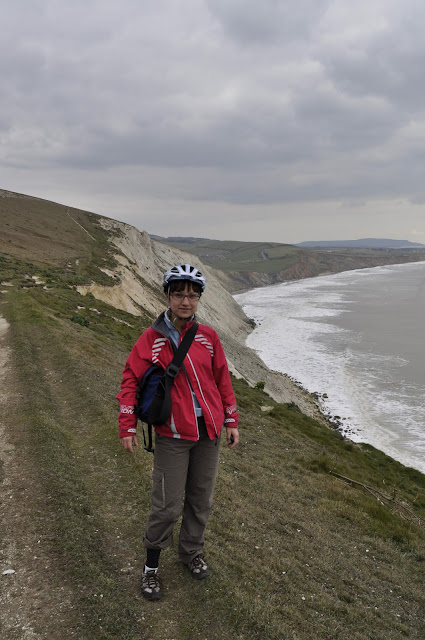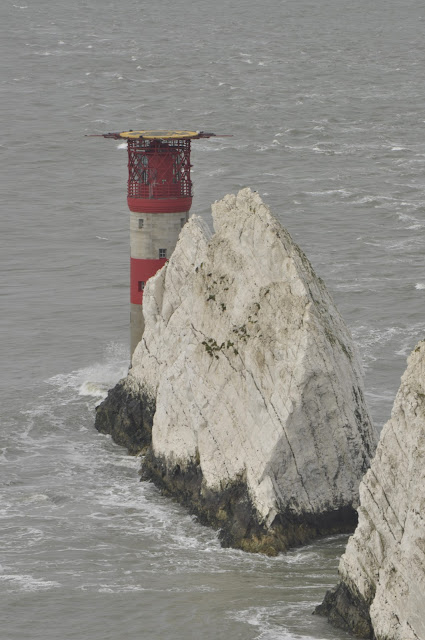Dia 2 - Totland a Ventnor
Arrancamos em mais uma fria manhã, mas depressa aquecemos. A rota para as
Baterias das Needles depressa começou a subir e bem... Mas valeu a pena. A famosa imagem do farol das Needles na extremidade da ilha, as vistas através do Solent, a história e a apresentação do monumento ao bom nivel que o National Trust já nos habituou.
Mudavamos agora da costa norte da ilha para a costa sul, vimos falésias e surfistas a gozar as frias águas do Canal da Mancha, mas acabamos por perder o programa do
Jardim de Mottistone. Está fechado às sextas e sábados, nada a fazer. Acabamos por parar para aquecer num
pub em Hulverstone e aproveitamos para a o almoço.
Tivemos a maior subida perto de Blackgang, com uma bela vista das falésias do seu topo. A descida seguinte levou-nos quase até Ventnor e que bem que soube. Ao 2º dia conseguimos chegar ao local de pernoita ainda de dia!!!
Ficamos nas Ventnor Towers, num quarto com janela na torre... a Diana adorou!
Desta vez saimos para jantar, enfrentando o frio subimos e descemos ruas. Ventnor é numa encosta bem inclinada, todas a casas têm vista de mar. Mas para jantar a escolha foi pouca. Fui comer uma lasanha num restaurante de "seafood"...
Dia 3 - Ventnor a Sandown
A distância entre as 2 localidades é só 11km, mas fomos fazer os tipicos percursos tortuosos dos turistas. O sol marcou presença e mesmo com o frio sabia bem estar ao ar livre. Mais uma vez achei um bridleway para atalhar, mas desta vez já foi muita areia para as nossas camionetas (mas não demais ok! BTT nunca é demais se for feito com sol). Ligamos a
Godshill para ver as famosas casas de telhado de colmo e tirar umas fotos e depois seguimos para o
Shanklin Chine pela estrada. Sim, teve muito mais trânsito, mas foi muito mais pedalável.
O
chine é uma formação geológica decorrente da erosão e neste caso a garganta já está bastante humanizada e foi mesmo usado durante a 2ª Grande Guerra para o programa
PLUTO.
Daqui para Sandown fomos aproveitando o paredão mas, com a maré bem alta, uma das ondas ainda me molhou os pés!!! Passamos por Sandown para ver a
vila romana de Brading e fomos os últimos a sair. Com o vento a gelar os ossos depressa retomamos a Sandown, já era tempo de aquecer os dedos.
Dia 4 - Sandwon a Ryde
Dia mais curto, tanto em distância como em tempo. Dia de apanhar ferry e comboio para Londres, mas antes do ferry e almoço em Porstmouth tivemos tempo de visitar o
moinho de Bembridge e ver a baia de St. Helen.
O moinho está bem restaurado e a visita guiada por um entusiástico voluntário foi bem elucidativa de como toda a mecânica funciona e como era a vida de moleiro.
Quanto ao ferry, desta vez o Solent estava mais agitado e a viagem foi mais instável, mas não por isso mais lenta. Em 18 minutos puseram-nos de novo em terra seca...
Conclusões
A Ilha de Wight tem muito para ver, mas não é tão plana como me fizeram crer. Esteve bastante ventosa nestes 4 dias e as temperaturas não eram convidativas a pedalar. Aprendemos que algumas coisas são muito úteis, como a roupa corta-vento e luvas de ski. Faltou-nos um gorro (ocupa pouco espaço nos alforges e dar-nos-ia mais conforto à noite) e roupa mais quente para a noite (o espaço em 2 alforges é bastante, mas não chega para casacos de inverno). E em Wight ninguém usa cadeados...
Day 2 - Totland to Ventnor
It was cold outside but we quickly got toasty. The road to the Needles battery quickly started climbing and steeply, but was well worth it. The famous image of the Needles lighthouse from the western end of the isle, the views across the Solent and the visit to the Old Needles Battery National Trust property were a well spent morning.
We now moved from the north side of the island to the south coast, plenty of cliffs and surfers enjoying the cold water of the English Channel, but we missed out on the Mottistone Gardens. It closes on fridays and saturdays... So we ended up warming up at a pub in Hulverstone and having also our lunch break. It was quite cozy with a log fire going, so it was hard to leave. Winding through country lanes we ended up on the coast again and on the biggest climb of the weekend, near Blackgang. The view from the top was great and the following downhill took us nearly all the way to Ventnor. This day we managed to arrive at the accommodation in the daytime!!!
We stayed at the Ventnor Towers. The room had a quirky tower window, Diana loved it!
This time we braved the cold for dinner, up and down the Ventnor streets. The town is on an incline so wherever you live you will always have a sea view. But the options for dinner were quite limited. Ended up eating a lasagna in a seafood restaurant...
Day 3 - Ventnor to Sandown
If you take the closest route between the 2 towns, it would only take 11km to link them. But as typical tourists we went the long way. The sun had made an appearance and even with the wintery cold it felt great to be out and about. I found another shortcut to our first stop, Godshill. But this time I was biting more than we could chew (not that I am complaining about doing some off road riding, you can never get too much of that when it's sunny outside).
We did a quick stop at Godshill and admired the thatched roofed houses and then chose to go on the road to visit the Shanklin Chine. Yes, it was busier, but got us there with more pedaling and less pushing.
A Chine is a geological formation caused by erosion but this one is quite humanized, being used during World War II for the PLUTO program.
From here to Sandown we just followed the coast line through the Esplanade. The tide was high so we still got our feet wet form the waves. Left the current coast line to head to the roman villa of Brading and were the last ones out... The wind was now quite cold and we rushed to Sandown to warm our toes with a warm shower.
Day 4 - Sandwon to Ryde
This was to be the shortest day, both in time and distance. We had to get a ferry before lunch, but still managed some time to visit the Bembridge Mill and St Helen's bay.
The windmill is very well restored and our guide for the visit was a very enthusiastic volunteer. We came out with a good idea of a miller's life and the workings of all those wheels.
The ferry ride was a bit bumpier, but not the least slower. We were in Portsmouth in 18 minutes...
Conclusion
The Isle of wight has a lot to see, but isn't as flat as I thought. It was quite windy during these 4 days and the temperatures were not the best for cycletouring... We've learned that wind blocking clothing a ski gloves are quite useful. We missed a woolie hat (would take little space in the panniers and give us more comfort in the evenings) and some warmer coats (the space in 2 panniers is plenty, but not unlimited). And in Wight no one uses bike locks...


































































